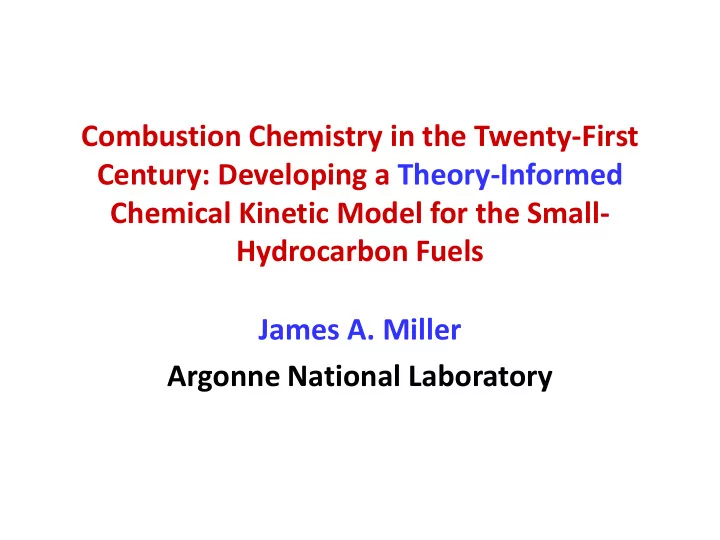

Combustion Chemistry in the Twenty-First Century: Developing a Theory-Informed Chemical Kinetic Model for the Small- Hydrocarbon Fuels James A. Miller Argonne National Laboratory
Collaborators/Co-Authors/Partners • Stephen • Ahren Jasper Klippenstein • Judit Zádor • Raghu • Nils Hansen Sivaramikrishnan • Michael Burke (Columbia) • Peter Glarborg • Franklin Goldsmith (Brown) • Yuri Georgievski • Larry Harding • Branko Ruscic
Support • Argonne-Sandia High-Pressure Combustion Consortium – DOE Office of Basic Energy Sciences
Distinguishing Characteristics of Present Model • Focus on C 0 -C 3 chemistry (plus methanol and ethanol) – molecules large enough to exhibit low- temperature chemistry, small enough to be attacked with high-level electronic-structure methods • Relies heavily on theory (thermochemistry, transport, chemical kinetics) • Focus on extension to high pressure • No fitting, no “optimization”, no adjustable parameters
What does “high pressure” mean?
Thermochemistry • Active Thermochemical Tables • Very High-Level Electronic Structure Theory: C-H-O-N species with 34 or fewer electrons – 4 (or 5) heavy atoms
High Accuracy Ab Initio Thermochemistry Central Elements • CCSD(T)/TZ rovibrational analysis • CCSD(T)/CBS(AQZ,A5Z) • CCSDT(Q)/DZ – CCSD(T)/DZ Minor Corrections • Core-Valence CCSD(T,full)/CBS(pcVTZ,pcVQZ) • Anharmonic Vibration Corrections B3LYP or MP2 • Relativistic CI(aug-cc-pcvtz) • Diagonal Born-Oppenheimer HF/TZ 2 σ Accuracy ~ 0.2 kcal/mol Replace with CASPT2 and/or CI+QC as necessary 7
Transport Properties 2 Objectives 1. Provide accurate Lennard-Jones parameters for use in flame calculations 2. Test accuracy of isotropic/Lennard-Jones potential Methods • Calculate σ and ε for N 2 - X from “ isotropically averaged potential” using MP2/ aug’dz method – use combining rules to get self parameters • Calculate collision integral (diffusion) “exactly” from classical trajectories using fitted potentials • Calculate dipole moments and polarizabilities from high- level electronic structure theory
Lennard-Jones Potential V(r) σ r ε ij ij 12 6 V r ( ) 4 ( ) ( ) ij r r
H – N 2 interaction
H 2 – N 2 interaction
C 3 H 8 – N 2 interaction
Chemical Kinetics • RRKM/non-RRKM behavior • Dissociation of weakly-bound free radicals • Multiple-well, multiple-product-channel problems
Types of Chemical Reactions
RRKM Intramolecular Dynamics
H+O 2 OH+O
Effect of non-RRKM Behavior in H+O 2 OH+O
3 CH 2 +O 2 →products Courtesy of Alex Landera
3 CH 2 +O 2 Rate Constants Courtesy of Alex Landera
Weakly-bound free radicals • Dissociate primarily to form stable molecule and another free radical • Low threshold energies for dissociation (weak bonds ) with “intrinsic” potential energy barriers • Examples: vinyl, ethyl, n- and i-propyl (all alkyl radicals), allyl, formyl , … • Not weakly bound- methyl, propargyl, …
The Dissociation of Formyl Radical Argon collider Timonen, et al 1987 Friedrichs ,et al 2002 Krasnoperov Helium collider Yang, Tan, Carter, and Ju, U.S. National Meeting 2013
HCO dissociation tunneling Reaction threshold energy
Yang, Tan, Carter, and Ju, U.S. National Meeting 2013
Non-equilibrium population distributions during dissociation of weakly-bound free radicals • Non-equilibrium factor, f ne , occurs naturally in the analytical treatment of reversible dissociation x E ( ) f 1/ x E dE ( ) ne F E ( ) 0 • Measure of the extent to which dissociation “disturbs” the equilibrium population distribution • If f ne is significantly smaller than 1, get significant disturbance ⇒ dissociation during vibrational relaxation ⇒ inadequacy of phenomenological (rate constant) description
Non-Equilibrium factors for Selected Radicals
Propyl radicals n-C 3 H 7 i-C 3 H 7
Possible Solution • Internal energy relaxation is presumed to be infinitely fast in phenomenological models • Dissociated radical is formed before “thermalization” is complete • Take dissociated radical to be formed from radical-producing reactions, e.g. C 2 H 6 +OH C 2 H 5 +H 2 O C 2 H 6 +OH C 2 H 4 +H+H 2 O
Reactions Investigated (or Re-Investigated) for this Project Everything on C 3 H 7 potential, …C 3 H 6 …,… C 3 H 5 O…, …C 2 H 4 …,C 2 H 5 +H, C 2 H 5 +OH,C 2 H 5 +O 2 ,C 3 H 7 +O 2 ,C 3 H 3 dissociation, 3 CH 2 +O 2 , HCO+OH, CH 2 OH/CH 3 O dissociation,C 2 H 3 +O 2 , dissociation of hydroxypropyl and propoxy radicals , etc. (probably a number that I have forgotten)
CH 3 +OH products
CH 3 +OH products
Comparison with Experiment
Propane Ignition Delay Times
Low-Temperature Autoignition of Propane Gallagher, et al (2008)
Recommend
More recommend